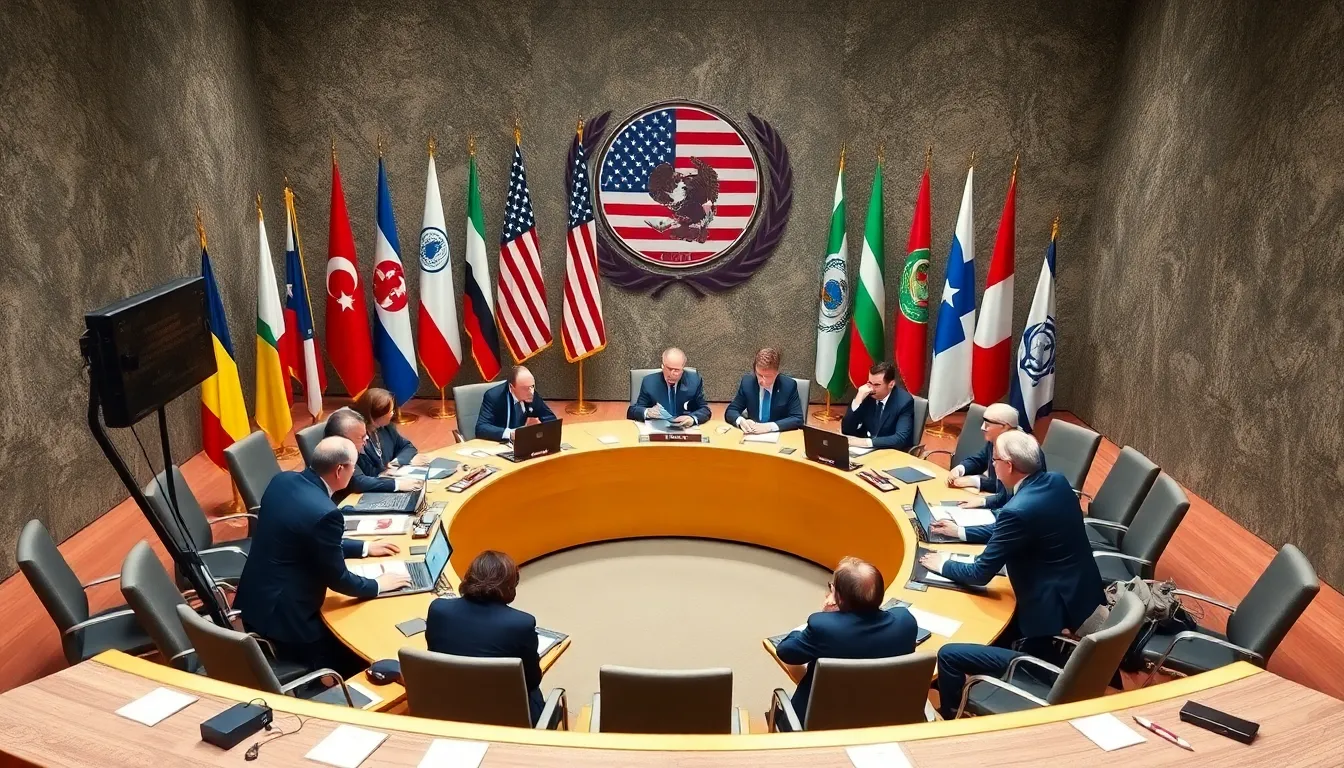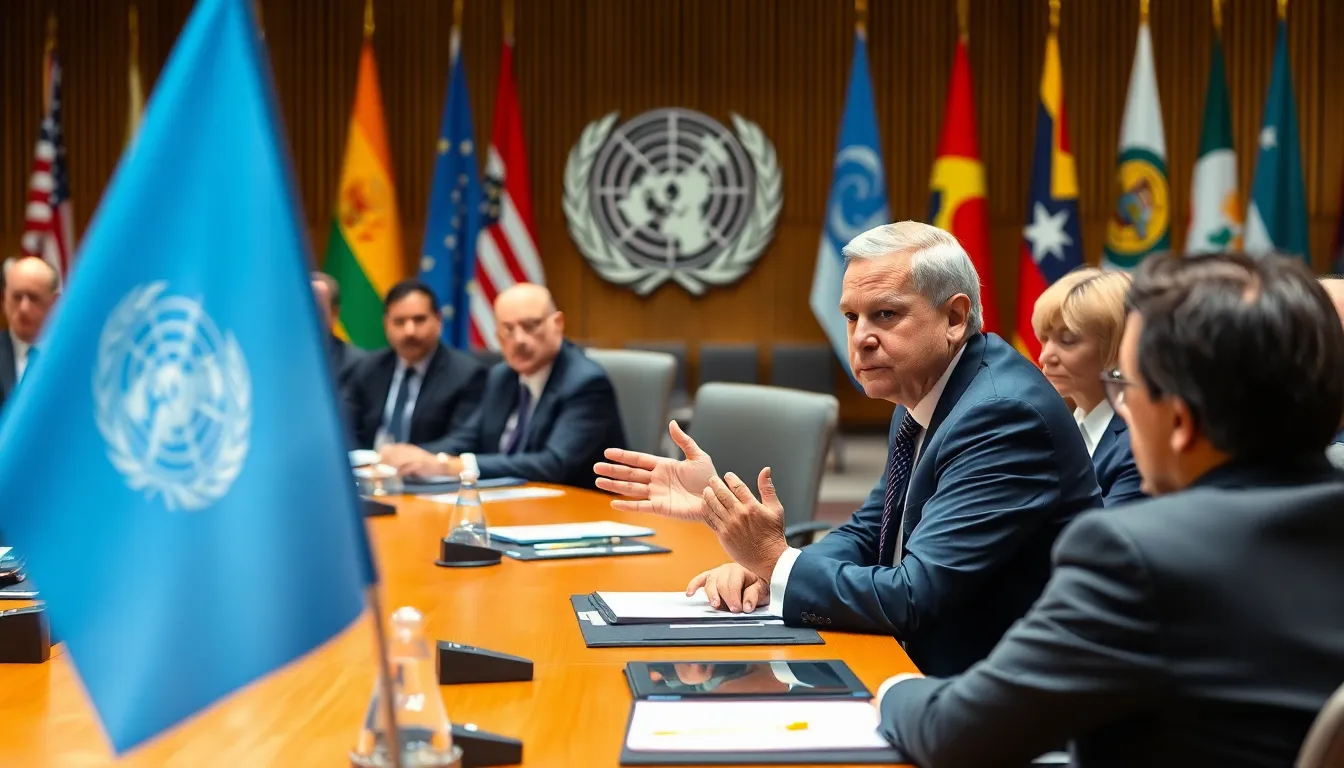When it comes to global governance, United Nations resolutions are like the world’s most important to-do list—except instead of chores, it’s tackling issues like peace, human rights, and climate change. These resolutions may not come with a catchy theme song, but they play a crucial role in shaping international relations.
Imagine a giant meeting room filled with diplomats armed with coffee and a shared goal: making the world a better place. Each resolution represents a collective hope, a diplomatic handshake, or sometimes a polite way of saying, “We really need to do something about that.” So, buckle up as we dive into the fascinating world of UN resolutions, where every vote counts and every word matters.
Table of Contents
ToggleOverview of United Nations Resolutions
United Nations resolutions play a vital role in international governance. These formal decisions reflect the collective stance of member states on pressing global concerns. Each resolution addresses specific issues ranging from peacekeeping initiatives to the promotion of human rights.
Resolutions serve various purposes, including the establishment of international norms and standards. For example, they often outline strategies for conflict resolution or define frameworks to combat climate change. Recognizing the implications of each resolution is essential for understanding global dynamics.
In many instances, resolutions can lead to binding agreements, depending on their context and the authority of the UN body involved. Security Council resolutions, for instance, are particularly notable for their mandatory nature, impacting member states directly when action is required.
General Assembly resolutions, on the other hand, typically express political opinions or recommendations. While these documents carry significant moral weight, they do not possess the same legal authority as those from the Security Council.
Understanding the processes behind UN resolutions is crucial. Drafting involves collaboration among member states, followed by negotiations to reach consensus. The voting process showcases the diplomatic dance necessary to finalize resolutions.
Furthermore, the impact of these resolutions extends beyond immediate outcomes. Historical examples illustrate how UN resolutions shape international law and influence policies within nations. They provide guidelines that help direct the behavior of states and non-state actors alike.
Through resolutions, the United Nations seeks to unify global efforts aimed at addressing challenges. Each decision encapsulates the aspirations of member states toward a more peaceful and just world.
Types of United Nations Resolutions

UN resolutions serve different functions and originate from various bodies within the organization. Understanding these types reveals how the UN addresses global challenges.
General Assembly Resolutions
General Assembly resolutions represent the consensus of member states on a wide range of issues. These resolutions primarily express political opinions and provide recommendations, lacking binding authority. Specifically, they cover topics such as human rights, sustainable development, and peace initiatives. Annual sessions often see the adoption of numerous resolutions, influencing international norms. Moreover, while not legally enforceable, they carry significant weight in shaping global dialogue and policy.
Security Council Resolutions
Security Council resolutions focus on maintaining international peace and security. These resolutions can create binding obligations for UN member states, allowing swift action in response to threats. Often, they address issues like armed conflict, sanctions, and peacekeeping missions. Examples include resolutions aimed at stopping conflicts or preventing human rights violations. Such actions illustrate the Security Council’s role in enforcing compliance and promoting stability globally.
Importance of United Nations Resolutions
United Nations resolutions hold significant value in shaping global governance and guiding collective action among member states.
Influence on International Law
UN resolutions lay foundational frameworks that often evolve into international law. Through Security Council resolutions, binding obligations emerge, compelling states to adhere to the terms set forth. For example, Resolution 1973 authorized military intervention in Libya, reshaping norms regarding state sovereignty. General Assembly resolutions, while non-binding, influence legal perspectives by promoting human rights standards and environmental protections. They encourage nation-states to align their legislation with global commitments, influencing treaty development and customary law. Thus, UN resolutions actively contribute to a structured legal landscape, fostering accountability among nations.
Impact on Global Politics
The influence of UN resolutions extends deeply into global political dynamics. Resolutions often reflect the consensus or divisions among powerful nations, affecting diplomatic relations and negotiations. In 2021, Resolution 2532 aimed to promote global ceasefire amidst the pandemic, showcasing how the UN addresses emergent threats. Furthermore, resolutions can galvanize international coalitions, driving collaborative responses to crises. As states respond to these directives, they signal commitment to multilateralism, shaping perceptions on governance and cooperation. Hence, UN resolutions play a pivotal role in determining the course of global politics and conflict resolution.
Criticisms of United Nations Resolutions
Various criticisms surround United Nations resolutions, particularly regarding their effectiveness and implementation challenges.
Effectiveness Issues
Skeptics often question the effectiveness of UN resolutions. Critics point out the disparity between statements of intent and real-world outcomes. Resolutions may express the collective will of member states, but they rarely compel immediate action. Some member states ignore or bypass resolutions, evidenced by selective compliance with Security Council mandates. Historical examples, like instances of military intervention without UN authorization, highlight this concern. Moreover, the influence of powerful nations can skew resolutions, leading to political maneuvering rather than genuine cooperation. Consequently, the perceived ineffectiveness can diminish the authority of the United Nations on the global stage.
Implementation Challenges
Implementation challenges also undermine the impact of UN resolutions. Limited resources often hinder the execution of mandates, especially in peacekeeping operations. Inadequate funding affects the ability to deploy missions effectively. Member states might also lack political will, creating obstacles in translating resolutions into on-the-ground actions. Disparate interpretations of obligations can further complicate compliance. Some nations interpret resolutions in ways that serve their interests rather than the intent of the international community. These challenges ultimately create a gap between resolution aims and tangible results, raising concerns about the UN’s role in international governance.
United Nations resolutions embody the collective will of the international community in addressing pressing global challenges. They serve as essential tools for promoting peace and stability while influencing national policies and international norms. Despite their potential, the effectiveness of these resolutions often faces scrutiny due to implementation hurdles and the varying commitment levels of member states.
As the world continues to confront complex issues, the role of UN resolutions remains critical. They not only reflect diplomatic efforts but also shape the landscape of global governance. By understanding their significance and limitations, stakeholders can better appreciate the ongoing journey toward a more united and peaceful world.







